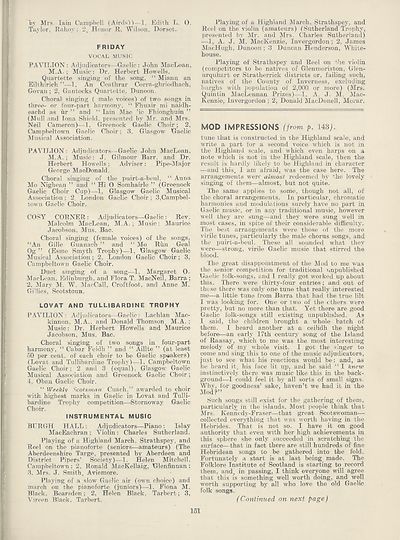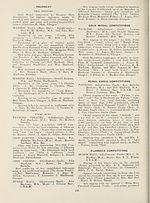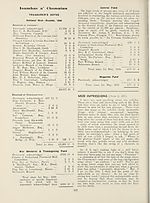An Comunn Gàidhealach Publications > Gaidheal > Volumes 44--45, January 1949--December 1950
(517) Page 151
Download files
Complete book:
Individual page:
Thumbnail gallery: Grid view | List view

fcy Mrs. Iain Campbell (Airds))—1, Edith L. O.
Taylor, Rahov; 2, Honor R. Wilson, Dorset.
FRIDAY
VOCAL MUSIC
PAVILION : Adjudicators—Gaelic: John MacLean,
M.A. ; Music: Dr. Herbert Howells.
Quartette singing of the song, “ Miann an
Eilthirich ”—1. An Ceathrar Corra-ghriodhach,
Govan; 2, Gantocks Quartette, Dunoon.
Choral singing ( male voices) of two songs in
three- or four-part harmony, “ Fhuair mi naidh-
eaehd as ur ” and “ Iain Mac ’ic Fhionghuin ”
(Mull and Iona Shield, presented by Mr. and Mrs.
Neil Cameron)—1. Greenock Gaelic Choir; 2,
Campbeltown Gaelic Choir; 3, Glasgow 'Gaelic
Musical Association.
PAVILION: Adjudicators—Gaelic John MacLean,
M.A. ; Music: J. Gilmour Barr, and Dr.
Herbert Howells; Adviser: Pipe-Major
George MacDonald.
Choral singing of the puirt-a-beul, “ Anna
Mo Nighean ” and “ Hi O Somhairle ” (Greenock
Gaelic Choir Cup)—1, Glasgow Gaelic Musical
Association; 2. London Gaelic Choir; 3,Campbel¬
town Gaelic Choir.
COSY CORNER : Adjudicators—Gaelic: Rev.
Malcolm MacLean, M.A. ; Music: Maurice
Jacobson, Mus. Bac.
Choral singing (female voices) of the songs,
“An Gille Guanach ” and “ Mo Run Geal
Og ” (Esme Smyth Trophy)—1, Glasgow Gaelic
Musical Association; 2, London Gaelic Choir; 3,
Campbeltown Gaelic Choir.
Duet singing of a song—1, Margaret 0.
MacLean. Edinburgh, and Flora T. MacNeil, Barra ;
2. Mary M. W. Mar-Call, Croftfoot, and Anne M.
Gillies, Scotstoun.
LOVAT AND TULUBARDINE TROPHY
PAVILION: Adjudicators—Gaelic: Lachlan Mac-
kinnon, M.A., and Donald Thomson. M.A. ;
Music: Dr. Herbert Howells and Maurice
Jacobson, Mus. Bac.
Choral singing of two songs in four-part
harmony, “ Cabar Feidh ” and “ Aillte ” (at least
50 per cent, of each choir to be Gaelic speakers)
(Lovat and Tullibardine Trophy)—1, Campbeltown
Gaelic Choir; 2 and 3 (equal), Glasgow Gaelic
Musical Association and Greenock Gaelic Choir;
4, Oban Gaelic Choir.
“ Weekly Scotsman Cuach.” awarded to choir
with highest marks in Gaelic in Lovat and Tulli-
bardine Trophy competition—Stornoway Gaelic
Choir.
INSTRUMENTAL MUSIC
BURGH HALL : Adjudicators—Piano : Islay
MacEachran; Violin: Charles Sutherland.
Playing of a Highland March, Strathspey, and
Reel on the pianoforte (seniors—amateurs) (The
Aberdeenshire Targe, presented by Aberdeen and
District Pipers’ Society)—1. Helen Mitchell,
Campbeltown; 2, Ronald MacKellaig, Glenfinnan;
3, Mrs. J. Smith. Aviemore.
Playing of a slow Gaelic air (own choice) and
march on the pianoforte (juniors)—1. Fiona M.
Black, Bearsden; 2, Helen Black, Tarbert; 3,
Vireen Black, Tarbert.
Playing of a Highland March, Strathspey, and
Reel on the violin (amateurs) (Sutherland Trophy,
presented by Mr. and Mrs. Charles Sutherland)
—1, A. J. M. MacKenzie, Invergorden; 2, James
MacHugh, Dunoon; 3 Duncan Henderson, White-
house.
Playing of Strathspey and Reel on the violin
(competitors to be natives of Glenmoriston, Glen-
urquhart or Stratherrick districts or, failing such,
natives of the County of Inverness, excluding
burghs with population of 2,000 or more) (Mrs.
Quintin MacLennan Prizes)—1, A. J. M. Mac¬
Kenzie, Invergordon; 2, Donald MacDonell, Morar.
MOD IMPRESSIONS f/rom p. US).
tune that is constructed in the Highland scale, and
write a part for a second voice which is not in
the Highland scale, and which even harps on a
note which is not in the Highland scale, then the
result is hardly likely to be Highland in character
—and this, I am afraid, was the case here. The
arrangements were almost redeemed by the lovely
singing of them—almost, but not quite.
The same applies to some, though not all, of
the choral arrangements. In particular, chromatic
harmonies and modulations surely have no part in
Gaelic music, or in any traditional music, however
well they are sung—and they were sung well in
most cases, in spite of their considerable difficulty.
The best arrangements were those of the more
virile tunes, particularly the male chorus songs, and
the puirt-a-beul. These all sounded what they
were—strong, virile Gaelic music that stirred the
blood.
The great disappointment of the Mod to me was
the senior competition for traditional unpublished
Gaelic folk-songs, and I really got worked up about
this. There were thirty-four entries; and out of
these there was only one tune that really interested
me—a little tune from Barra that had the true lilt
I was looking for. One or two of the ethers were
pretty, but no more than that. Yet there are good
Gaelic folk-songs still existing unpublished. As
I said, the children brought a whole batch of
them. I heard another at a ceilidh the night
before—an early 17th century song of the Island
of Raasay, which to me was the most interesting
melody of my whole visit. I got the singer to
come and sing this to one of the music adjudicators,
just to see what his reactions would be: and, as
he heard it. his face lit up, and he said “ I knew
instinctively there was music like this in the back¬
ground—I could feel it by all sorts of small signs.
Why, for goodness’ sake, haven’t we had it in the
Mod?”
Such songs still exist for the gathering of them,
particularly in the islands. Most people think that
Mrs. Kennedy-Fraser—that great Scotswoman—
collected everything that was worth having in the
Hebrides. That is not so. I have it on good
authority that even with her high achievements in
this sphere she only succeeded in scratching the
surface—that in fact there are still hundreds of fine
Hebridean songs to be gathered into the fold.
Fortunately a start is at last being made. The
Folklore Institute of Scotland is starting to record
them, and. in passing, I think everyone will agree
that this is something well worth doing, and well
worth supporting by all who love the old Gaelic
folk songs.
(Continued on next page)
151
Taylor, Rahov; 2, Honor R. Wilson, Dorset.
FRIDAY
VOCAL MUSIC
PAVILION : Adjudicators—Gaelic: John MacLean,
M.A. ; Music: Dr. Herbert Howells.
Quartette singing of the song, “ Miann an
Eilthirich ”—1. An Ceathrar Corra-ghriodhach,
Govan; 2, Gantocks Quartette, Dunoon.
Choral singing ( male voices) of two songs in
three- or four-part harmony, “ Fhuair mi naidh-
eaehd as ur ” and “ Iain Mac ’ic Fhionghuin ”
(Mull and Iona Shield, presented by Mr. and Mrs.
Neil Cameron)—1. Greenock Gaelic Choir; 2,
Campbeltown Gaelic Choir; 3, Glasgow 'Gaelic
Musical Association.
PAVILION: Adjudicators—Gaelic John MacLean,
M.A. ; Music: J. Gilmour Barr, and Dr.
Herbert Howells; Adviser: Pipe-Major
George MacDonald.
Choral singing of the puirt-a-beul, “ Anna
Mo Nighean ” and “ Hi O Somhairle ” (Greenock
Gaelic Choir Cup)—1, Glasgow Gaelic Musical
Association; 2. London Gaelic Choir; 3,Campbel¬
town Gaelic Choir.
COSY CORNER : Adjudicators—Gaelic: Rev.
Malcolm MacLean, M.A. ; Music: Maurice
Jacobson, Mus. Bac.
Choral singing (female voices) of the songs,
“An Gille Guanach ” and “ Mo Run Geal
Og ” (Esme Smyth Trophy)—1, Glasgow Gaelic
Musical Association; 2, London Gaelic Choir; 3,
Campbeltown Gaelic Choir.
Duet singing of a song—1, Margaret 0.
MacLean. Edinburgh, and Flora T. MacNeil, Barra ;
2. Mary M. W. Mar-Call, Croftfoot, and Anne M.
Gillies, Scotstoun.
LOVAT AND TULUBARDINE TROPHY
PAVILION: Adjudicators—Gaelic: Lachlan Mac-
kinnon, M.A., and Donald Thomson. M.A. ;
Music: Dr. Herbert Howells and Maurice
Jacobson, Mus. Bac.
Choral singing of two songs in four-part
harmony, “ Cabar Feidh ” and “ Aillte ” (at least
50 per cent, of each choir to be Gaelic speakers)
(Lovat and Tullibardine Trophy)—1, Campbeltown
Gaelic Choir; 2 and 3 (equal), Glasgow Gaelic
Musical Association and Greenock Gaelic Choir;
4, Oban Gaelic Choir.
“ Weekly Scotsman Cuach.” awarded to choir
with highest marks in Gaelic in Lovat and Tulli-
bardine Trophy competition—Stornoway Gaelic
Choir.
INSTRUMENTAL MUSIC
BURGH HALL : Adjudicators—Piano : Islay
MacEachran; Violin: Charles Sutherland.
Playing of a Highland March, Strathspey, and
Reel on the pianoforte (seniors—amateurs) (The
Aberdeenshire Targe, presented by Aberdeen and
District Pipers’ Society)—1. Helen Mitchell,
Campbeltown; 2, Ronald MacKellaig, Glenfinnan;
3, Mrs. J. Smith. Aviemore.
Playing of a slow Gaelic air (own choice) and
march on the pianoforte (juniors)—1. Fiona M.
Black, Bearsden; 2, Helen Black, Tarbert; 3,
Vireen Black, Tarbert.
Playing of a Highland March, Strathspey, and
Reel on the violin (amateurs) (Sutherland Trophy,
presented by Mr. and Mrs. Charles Sutherland)
—1, A. J. M. MacKenzie, Invergorden; 2, James
MacHugh, Dunoon; 3 Duncan Henderson, White-
house.
Playing of Strathspey and Reel on the violin
(competitors to be natives of Glenmoriston, Glen-
urquhart or Stratherrick districts or, failing such,
natives of the County of Inverness, excluding
burghs with population of 2,000 or more) (Mrs.
Quintin MacLennan Prizes)—1, A. J. M. Mac¬
Kenzie, Invergordon; 2, Donald MacDonell, Morar.
MOD IMPRESSIONS f/rom p. US).
tune that is constructed in the Highland scale, and
write a part for a second voice which is not in
the Highland scale, and which even harps on a
note which is not in the Highland scale, then the
result is hardly likely to be Highland in character
—and this, I am afraid, was the case here. The
arrangements were almost redeemed by the lovely
singing of them—almost, but not quite.
The same applies to some, though not all, of
the choral arrangements. In particular, chromatic
harmonies and modulations surely have no part in
Gaelic music, or in any traditional music, however
well they are sung—and they were sung well in
most cases, in spite of their considerable difficulty.
The best arrangements were those of the more
virile tunes, particularly the male chorus songs, and
the puirt-a-beul. These all sounded what they
were—strong, virile Gaelic music that stirred the
blood.
The great disappointment of the Mod to me was
the senior competition for traditional unpublished
Gaelic folk-songs, and I really got worked up about
this. There were thirty-four entries; and out of
these there was only one tune that really interested
me—a little tune from Barra that had the true lilt
I was looking for. One or two of the ethers were
pretty, but no more than that. Yet there are good
Gaelic folk-songs still existing unpublished. As
I said, the children brought a whole batch of
them. I heard another at a ceilidh the night
before—an early 17th century song of the Island
of Raasay, which to me was the most interesting
melody of my whole visit. I got the singer to
come and sing this to one of the music adjudicators,
just to see what his reactions would be: and, as
he heard it. his face lit up, and he said “ I knew
instinctively there was music like this in the back¬
ground—I could feel it by all sorts of small signs.
Why, for goodness’ sake, haven’t we had it in the
Mod?”
Such songs still exist for the gathering of them,
particularly in the islands. Most people think that
Mrs. Kennedy-Fraser—that great Scotswoman—
collected everything that was worth having in the
Hebrides. That is not so. I have it on good
authority that even with her high achievements in
this sphere she only succeeded in scratching the
surface—that in fact there are still hundreds of fine
Hebridean songs to be gathered into the fold.
Fortunately a start is at last being made. The
Folklore Institute of Scotland is starting to record
them, and. in passing, I think everyone will agree
that this is something well worth doing, and well
worth supporting by all who love the old Gaelic
folk songs.
(Continued on next page)
151
Set display mode to:
![]() Universal Viewer |
Universal Viewer | ![]() Mirador |
Large image | Transcription
Mirador |
Large image | Transcription
| An Comunn Gàidhealach > An Comunn Gàidhealach Publications > Gaidheal > Volumes 44--45, January 1949--December 1950 > (517) Page 151 |
|---|
| Permanent URL | https://digital.nls.uk/127128240 |
|---|
| Description | This contains items published by An Comunn, which are not specifically Mòd-related. It includes journals, annual reports and corporate documents, policy statements, educational resources and published plays and literature. It is arranged alphabetically by title. |
|---|
| Description | A collection of over 400 items published by An Comunn Gàidhealach, the organisation which promotes Gaelic language and culture and organises the Royal National Mòd. Dating from 1891 up to the present day, the collection includes journals and newspapers, annual reports, educational materials, national Mòd programmes, published Mòd literature and music. |
|---|---|
| Additional NLS resources: |
|

